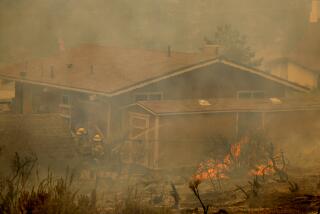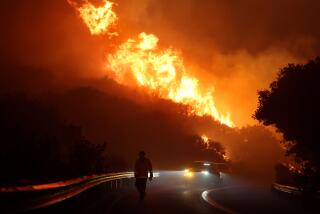Ready for fire season
Big Bear City residents Sue Oleson and Bob Jones live in one of the most gorgeous spots in Southern California -- and one of the most vulnerable to fire.
âItâs so dry here right now,â Oleson said. âThe trees are brown.â
Even though precipitation has been close to normal this year, according to Big Bear City Fire Chief Dana Van Leuven, four years of well-below-normal precipitation has stressed the pines and left them susceptible to attack from insect pests. In the Big Bear area, âthe bark beetle has caused between 10% and 39% tree mortality,â Van Leuven said, citing figures from an April 2003 Forest Service report, the most recent available.
Given the conditions, itâs not surprising that a recent âGood Morning Americaâ report on fire-retardant gel caught Olesonâs eye. The gel, which a homeowner can apply using a simple attachment to a garden hose, costs about $400 to $500, depending on the brand, to provide a 2,000-square-foot home with short-term protection.
âThatâs less than the cost of most peopleâs insurance deductible,â noted Mike Lerke, owner of RainDance Enterprises in Tijeras, N.M., and a distributor for Nochar E112 Fire Blocking Gel, one of several brands of fire-retardant gel being marketed to homeowners. The products are unrelated to the fire retardants that have raised concerns because of toxicity.
Oleson, 62, spent about $600 to purchase enough to cover her 1,325-square-foot chalet-style cabin plus a deck. âThatâs not a large house. But the deck is 800 square feet, and I would need to cover the top and bottom of it,â she said, adding that the deck is built around a 120-foot pine tree.
When she heard that John Bill Bartlett, the inventor of Barricade Fire Blocking Gel and the owner of Florida-based Barricade International, was coming to Big Bear to demonstrate the product to firefighters and residents, Oleson showed up at the demonstrations, video camera in hand. She then organized a presentation at her home for her Neighborhood Watch group.
Bartlett, a lieutenant with the Palm Beach County (Fla.) Fire Department, said the idea for the gel came to him during a less-than-glamorous firefighting assignment. In 1994, he and his partner were called to a home where several bags of trash had caught fire on the front porch. Standard post-fire âmop-upâ procedure called for opening the bags and checking the contents to make sure no embers remained.
âWe saw something that looked like white, unburned tissue paper, and we wondered why it hadnât burned,â he said. It was the remains of a used diaper.
The super-absorbent polymers, which are used in disposable diapers, hold many times their weight in water. Bartlett began thinking that perhaps polymers could be added to a liquid and sprayed on structures to protect them from fire. But he faced several challenges.
First, the polymers were available only in powder form. How could the powdered-polymer formula be converted into a liquid that could be stored in a small container when polymers immediately expand upon contact with water?
After much trial and error, and with the help of chemists, Bartlett discovered that mineral oil would hold the polymers in a liquid suspension, without expanding, so the resulting solution could be sold in jugs. Then the user could apply the mixture with a garden hose, adding the water that would cause the expansion of the polymers and create the fire-retardant gel.
Finally, in 1999, after Bartlett had tested some 47 versions of the product, Barricade Fire Blocking Gel was ready to go. Several other manufacturers came out with similar products about the same time.
The gels made quite an impression on firefighters. Today, every unit in the city of Los Angeles Fire Department is equipped with Barricade Gel, said Battalion Chief Bob Franco.
Barricade Gel has been responsible for saving âa couple hundred homesâ in western Montana over the past few years, according to Joe King, operations chief for Montana Wildfire Inc., a private firefighting company based in Bozeman. In Montana, the gel has been carried on trucks and applied by public and private firefighting units, King said. âItâs not a cure-all. But it has saved homes and it has helped keep firefighters safe.â
Los Angeles County Fire Department trucks carry a fire-retardant foam that similarly enables firefighters to protect a structure in the path of a fire, according to Capt. Anthony Williams. âYou can have a fire break thatâs 10 to 20 bulldozer blades wide, and you can still have enough radiant heat from the fire to endanger homes on the other side of the fire break,â Williams said. The foam can provide hours of protection.
Although fire-retardant foams are the choice of some fire departments, the gel formulas are being marketed to fire departments and homeowners.
When it comes to using the gel, proper instruction is crucial, Oleson has learned. âThis isnât something you just pick up at Wal-Mart and do yourself. You need someone knowledgeable who can come to your home and explain how to spray it on your particular house,â she said. âEvery home is different and has different areas that are vulnerable.â
Oleson has even made sure that the teenage son of a neighbor knows how to apply the gel to her home in case a fire threatens the neighborhood while sheâs out of town.
While manufacturersâ written instructions cover the basics, and some manufacturers offer video instruction, itâs helpful to locate a local distributor whose representative can come to the home, estimate the amount of gel needed and explain the finer points of application for a particular home.
Homeowners should also receive tips for safe application, such as the No. 1 warning mentioned by both manufacturers and firefighters: Always stand on a sturdy ladder when applying the gel to a roof. Do not stand on the roof itself, as the gel makes every surface slippery. In fact, Lerke said he asks customers to sign a liability release, given the gelâs slip-sliding potential.
Manufacturers list the gelâs shelf life at anywhere from five years to âindefinitely.â They also emphasize the importance of shaking the product several times a year and shaking again before use.
Depending on conditions such as sunlight, humidity and wind, fire-retardant gel can last from a minimum of six to eight hours to a maximum of 24 to 36 hours, although these estimates vary slightly by manufacturer. If the gel becomes dried out, it can be rehydrated with a light misting of water. The gel can be applied to a 2,000-square-foot house in about an hour, according to Bartlett.
Lerke said homeowners can apply the gel âhours or days aheadâ of an approaching fire, depending on humidity, the availability of either the homeowner or firefighters in the event the gel needs to be re-misted and, obviously, the seriousness of the threat at hand. Of course, homeowners should always follow the advice and direction of the firefighters in the area.
Personal safety comes first, stressed Bartlett, who agreed with Lerkeâs timetable and added, âYou donât do it while youâre standing there breathing smoke and seeing flames.â
Lerke also suggested storing the gel -- along with the instructions and applicator nozzle -- on a porch or deck in a box marked âFireâ so that firefighters have access to the box if the resident is not home.
Once applied, the slippery goo wonât disappear without effort. But if the house and belongings are intact after a serious fire, homeowners can count their blessings while they drag out the power washer.
âI try to be really honest with peopleâ when they ask how much the gel will harm the paint on their home, Bartlett said. âIt will weaken stain on a house. It doesnât break down paint, but it removes oxidized paint.â As a result, he said, a homeowner may need to repaint. But that sure beats losing the house.
Van Leuven suggested that consumers thoroughly research the brands of gel before choosing one. âSome are more friendly to paint and siding than others,â he said.
Lerke, who often speaks to homeowners associations, recommends that residents pool their funds and stockpile the gel for everyoneâs use. âFor $3,000 to $4,000, the residents can get two nozzles and enough gel to cover two dozen homes.â
While Oleson and Jones sleep better knowing they have this added protection tucked away, Oleson said her next goal is to make sure her neighbors and local firefighters are also well-equipped with the gel. In addition to holding demonstrations, she said she plans to help raise money âto put the gel on every firetruck in the Big Bear area.â
âRight now lots of people are interested,â she said. âThey just need to make the commitment so that, when the fire comes, theyâre not saying âWhereâs the gel?â â
*
Major makers of fire-retardant gels
More information about fire-retardant gels is available from these manufacturers:
Barricade International
Barricade Fire Blocking Gel
(800) 201-3927
www.barricadegel.com
Nochar
E112 Fire Blocking Gel
(317) 613-3046
www.nochar.com
Thermo Technologies Inc.
Thermo-Gel
(701) 258-8208
www.thermogel.com
Kathy Sena can be reached at [email protected].
More to Read
Sign up for Essential California
The most important California stories and recommendations in your inbox every morning.
You may occasionally receive promotional content from the Los Angeles Times.










